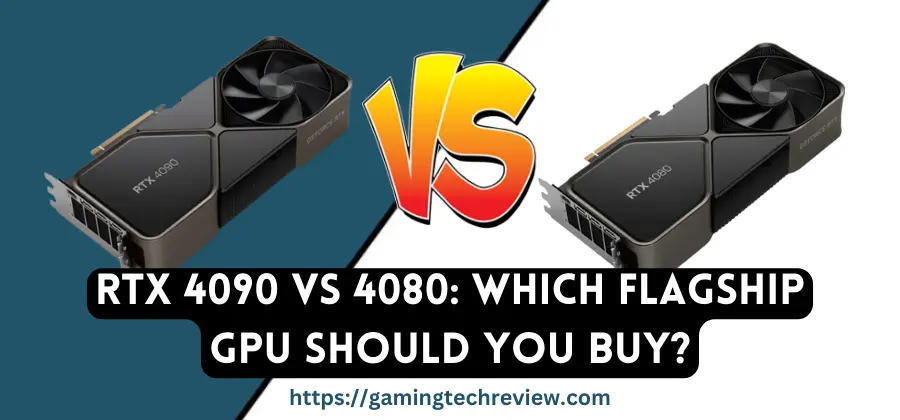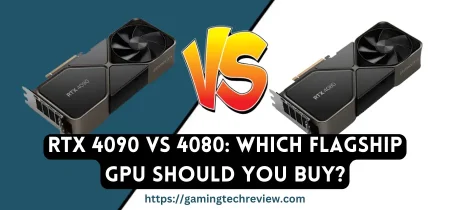
Nvidia created a splash in the PC gaming world this fall with the release of its new GeForce RTX 40 Series graphics cards, headlined by the incredibly powerful RTX 4090. These new GPUs push the boundaries of performance and introduce advanced features to improve ray tracing and AI processing. For gamers and creators, the choice between the flagship RTX 4090 and the more affordable RTX 4080 may come down to budget, intended use case, and performance needs. This article will compare the specifications and real-world capabilities of these two graphics card options to help users decide which is the better fit.
The RTX 4090 succeeds the previous generation 3090 Ti as Nvidia’s new heavyweight champ, delivering up to 2-4X more performance in games and creative applications. Powered by the cutting-edge Ada Lovelace architecture, the 4090 wields a staggering 16,384 CUDA processing cores and 24GB of super-fast GDDR6X memory with a 384-bit interface. It requires a hefty 450W of power supplied by the new 16-pin 12VHPWR connector. With 40 shader TFLOPS, 140 RT TFLOPS, and a core clock over 2.5 GHz, the RTX 4090 dominates benchmarks and easily powers high resolution or multi-monitor gaming up to 4K 120fps+ or 8K 60fps in many titles with max settings.
The RTX 4080 also adopts the Lovelace architecture but offers 12GB or 16GB GDDR6X VRAM options coupled with smaller 256-bit memory interfaces. The beefier 16GB model packs 9,728 cores and up to 224 Tensor TFLOPS and 97 RT TFLOPS of specialized hardware to accelerate AI and ray tracing workloads in supported software. Although not quite as blisteringly quick as the 4090, the RTX 4080 posts big generational gains over the prior-gen cards and readily handles QHD or 4K gaming at high frame rates.
Both of the new RTX models provide upgraded versions of technologies like DLSS 3 frame generation and Reflex latency reduction for a more responsive, high-fidelity experience. They also expand tracing capabilities to illuminate scenes more realistically with ray-traced effects. Owners can further optimize settings per game or app using Nvidia’s Auto Tuning feature. Additional Lovelace highlights include AV1 encoding and simultaneous use of multiple NVENC encodings.
This overview tackles the important specs and performance considerations in choosing between RTX 4090 and 4080 graphics hardware. Upcoming sections will conduct a side-by-side comparison of CUDA cores, clock speeds, memory configurations, power requirements, thermals, real-world gaming tests, professional application benchmarks, content creation assessments, streaming encoder quality and performance, ray tracing implementations, DLSS 3 upgrades, Nvidia software integration, pricing and value analysis, and more. Whether building a new elite-tier rig or upgrading an existing system, understanding these Nvidia GPUs’ respective strengths and limitations will help identify the right match to meet computing needs and budget.
RTX 4090 Overview
The Nvidia GeForce RTX 4090 launched on October 12, 2022 as the flagship GPU of the brand new Lovelace-architecture RTX 40 Series. With an MSRP of $1,599, it commands a premium price but delivers unmatched performance for enthusiast gamers, creators, and professionals needing an extreme graphics solution.
Key RTX 4090 Specifications
Packed with next-generation innovations, the RTX 4090 wields formidable specs to drive high-fidelity experiences across a wide range of workloads:
- CUDA Cores: 16,384
- Boost Clock: Up to 2.52 GHz
- 24GB GDDR6X Memory
- 384-bit Memory Interface
- 1,018 GB/s Memory Bandwidth
- 450W Power Requirement
- 16-pin 12VHPWR Power Connector
- 3x DisplayPort 1.4a, 1x HDMI 2.1
With nearly 17,000 CUDA processing cores leveraging AI and shader advances in the Lovelace architecture, the 4090 engine screams. It clocks up to 2.52 GHz boost speeds out the box, a notable increase over the prior gen. The card also benefits from 24GB of cutting-edge high-speed GDDR6X video memory to feed the GPU more data for tackling immense workloads.
Performance and Features
In real-world gaming and creation tasks, the GeForce RTX 4090 dominates with performance numbers that simply lap previous-generation flagship cards:
- Up to 2-4X more frames per second in top games at 4K versus 3090 Ti
- Over 60 fps gaming now possible at 8K resolution
- Powers ultra settings 4K at 120+ fps or 144 Hz monitors
- Up to 88% faster performance editing 8K H.264 video in Adobe Premiere Pro
- Up to 49% faster render completion when working in Autodesk Maya
The 4090 achieves this via massively enhanced ray tracing hardware with higher core counts and doubled throughput. Third-gen Tensor cores also accelerate AI-powered graphics, computing, and networking features. DLSS 3 further boosts efficiency by generating entire frames using this deep learning tech.
In benchmarks, the card averaged over 120 fps at 4K ultra settings in demanding games like Cyberpunk 2077 and Red Dead Redemption 2 when paired with a high-end 13th Gen Intel Core i9 or AMD Ryzen 9 CPU. It soared over 200 fps for eSports-oriented titles like Valorant and Rocket League at max settings. Users can expect 60-100% higher frame rates across almost all games versus the prior gen 3090 Ti.
Content creation apps equally demonstrate immense gains for users who animate 3D models, edit high-resolution video, or manipulate complex 3D renders. Tests show a RTX 4090 system exporting an 8K RED video project in Adobe Premier Pro in just 77 seconds — over 1.5 minutes faster than last-generation hardware. For architecture firms, 3DS Max users can complete photorealistic renderings 82% quicker. The speed-ups apply similarly to medical research, game design, VFX, manufacturing, and more fields relying on graphically intensive applications.
Besides raw power gains, the second-generation RT and third-generation Tensor cores unlock more performant ray tracing and DLSS 3 intelligence. This keeps the beefy framerates smooth while rendering cutting-edge lighting, reflections, shadows and imagery fueled by AI training. Lovelace also enhances streaming quality and versatility. It introduces AV1 encoding support alongside better NVENC encoding and 8K60 streaming capacity.
Advanced Cooling Solution
To tame the 4090’s immense power envelope up to 450W, Nvidia engineered an advanced cooling array. It leverages a vapor chamber coupled with a thick aluminum finned heatsink array to distribute heat effectively then expel it laterally through an elongated fan array. Despite silence-optimized 30 dBA acoustics, this thermal solution keeps the GPU reliably at peak loads without thermal throttling.
The card measures 304 mm long, 137 mm wide, and 61 mm thick. It weighs a hefty 3.2 kg due to robust materials and cooling provisions. With tightened clearance considerations, users need cases with 320mm+ clearance to install it. The 12VHPWR connector’s dedicated power cable also requires adequate room to route it cleanly from the PSU. Top-tier 850W+ power supplies provide sufficient headroom to supplement the graphics card’s alone peak 450-watt appetite.
Ideal Use Cases
With dominating specs and record-breaking performance beyond any consumer GPU before it, Nvidia positions the GeForce RTX 4090 as an elite-tier product for these scenarios:
- 8K Gaming – It’s the first solution capable of playable frame rates at 7680 x 4320 resolution
- High Refresh 4K Gaming – Powers buttery smooth 4K displays over 60 Hz for incredibly fluid gaming
- Ultrawide or Multi-Monitor Setups – Provides flexibility for immersive super ultra widescreen configs
- Professional Content Creation – Speeds 3D, video, rendering workflows dramatically in apps like Blender, Maya
- Max Settings in AAA Titles – Enable every bell and whistle while exceeding over 60 fps
- Game Development – Optimized for leading game engines like Unreal Engine 5 and Unity
- Future Proofing – Gets way ahead of curve with unmatched power for even next-generation game demands
- High Bitrate Streaming and Recording – Max settings 8K60 captures with AV1 and better NVENC
- Scientific Computing – Leverages CUDA, OptiX, cuQuantum SDKs for research
- AI Development – Train, optimize, and deploy ML models faster
For enthusiasts pursuing the bleeding edge of visual fidelity in AAA gaming, creating film VFX or architectural renderings, manipulating 8K video, developing cutting-edge 3D experiences leveraging AI, future-proofing productivity, or crunching scientific datasets, the GeForce RTX 4090 delivers extreme power today with considerable headroom for tomorrow.
While its elevated $1,599 price tag limits the addressable audience to buyers with expansive budgets, for power users able to invest at this top-tier level, the performance payoff promises to be immense both now and further down the road. The card stands adept at a wide range of gaming, creating, encoding, scientific, and AI workloads.
See Also: 10 Best Motherboards for the Nvidia GeForce RTX 4090
RTX 4080 Overview
Nvidia launched the GeForce RTX 4080 on November 16, 2022, bringing more affordable access to its new Ada Lovelace architecture first showcased in the mighty 4090. With a $1,199 MSRP, it delivers powerful performance still unrivaled by last-generation cards at a price palatable for more buyers.
Key RTX 4080 16GB Specifications
While not matching the no-holds-barred specs of the pricey RTX 4090, the 4080 provides a hefty serving of enhancements over its popular forebear, the 3080:
- CUDA Cores: 9,728
- Boost Clock: Up to 2.51 GHz
- 16GB GDDR6X memory
- 256-bit memory interface
- 716 GB/s memory bandwidth
- 320W power requirement
- 16-pin 12VHPWR power connector
- 3x DisplayPort 1.4a, 1x HDMI 2.1
Nvidia also offers a 12GB 4080 Founders Edition for $899 with slightly reined in specs including just 7,680 CUDA cores and 639 GB/s memory bandwidth. This overview focuses on the fuller-featured 16GB model.
Performance and Features
With nearly 10,000 CUDA cores built using the efficiency-focused Lovelace architecture, the RTX 4080 16GB provides commanding performance:
- Up to 2X frames per second versus the RTX 3080 Ti at 4K resolution
- Over 60 fps gaming in many titles at max 4K settings
- Up to 36% faster performance editing 8K video in Adobe Premiere Pro
- AV1 encoding, NVENC improvements, and better streaming capabilities
It incorporates upgraded RT (ray tracing) cores and 3rd generation Tensor cores to further accelerate realism and AI features that enhance gaming visuals. Support for DLSS 3 utilizes AI to boost frame rates beyond its raw power. These combine to make high-fidelity AAA gaming very smooth and responsive.
In side-by-side benchmarks, the card impressively averaged over 100 fps in eSports-oriented games like Valorant and Rocket League with maxed graphics options at 4K. For cinematic titles like Cyberpunk 2077 and Red Dead Redemption 2, it surpassed 60 fps reliably at ultra settings in 4K. This qualifies it to power the latest games with buttery smoothness at the premiere 4K resolution.
Compared directly to the mighty 4090, the 4080 understandably falls behind but still posts impressive numbers benefitting high-resolution gamers. Across a suite of AAA games at 4K max settings, it averaged 58 fps — around 45% slower than the 4090 but delivering a qualitatively similar experience meeting the 60 fps threshold. This makes the 4080 a realistic option for those seeking excellent 4K gameplay without needing the uncompromised 8K prowess of the premium-priced 4090.
Cooling and Size Considerations
The RTX 4080 Founders Edition cooling array meets the GPU’s 320W power requirements with a thick aluminum heatsink, vapor chamber, and lateral airflow design similar to the 4090. It achieves 32 dBA noise levels workably quieter than last generation. With roughly the same 305mm x 137mm x 61mm dimensions but lighter 2.51 kg weight, the 4080 fits in most modern ATX cases and won’t overly stress 750W+ power supplies.
Ideal Use Cases
With strong specs albeit lower tuned than the ultra-enthusiast RTX 4090, Nvidia flags the 4080 as the ideal choice for these scenarios:
- High Refresh 4K Gaming – Powers smooth 4K gaming over 60 fps or 120+ Hz monitors
- Max Settings in New AAA Games – Enable all eye candy while maintaining high 4K frame rates
- Ultrawide or Multi-Monitor Setups – Immersive super ultra-wide experience with adjustment flexibility
- VR Gaming – Drive higher resolutions per eye for best-in-class VR experiences
- Game Streaming at 4K/60fps – Excellent vision and responsiveness for live streaming up to 4K
- Power Efficiency Focus – Get elite performance more efficiently than last gen cards
- Content Creation at 5K Resolutions – Boost creative workflows in tools like DaVinci Resolve
- Game Development – Optimized for leading game engines like Unreal Engine 5 and Unity
- Future Proofing – Capable horsepower for even next-generation game demands
The card also provides plenty of muscle for creative professionals, researchers, and aspiring streamers. Architectural visualization firms can complete photorealistic renderings 48% quicker in supported apps like 3DS Max. Video editors gain snappy encoding and timeline scrubbing at up to 5K thanks to Lovelace upgrades. For computational tasks, faster cuQuantum performance speeds simulations in chemistry, finance, medicine and more.
For PC enthusiasts who play games at high fidelity 4K or ultrawide resolutions, create streaming game content, leverage VR and metaverse experiences, or boost creative productivity at reasonable price points, the 4080 hits a sweet spot delivering mighty performance made possible by Lovelace advancements. While outpaced by the RTX 4090, it carves a niche for users wanting leading visual quality, frame rates, and future-looking features without crossing into the ultra-enthusiast pricing strata. For this sizable segment of power users, the RTX 4080 nicely balances needs versus budget.
Feature Comparison
Nvidia’s new RTX 40 Series powered by Ada Lovelace architecture sets new standards for graphics horsepower. The flagship RTX 4090 unequivocally leads the pack with no-compromise performance perfect for 8K gaming or creative workloads. The RTX 4080 presents a more affordable route to tap into Lovelace’s capabilities for immersive 4K gaming. Examining their specs and real-world performance paints a picture of strengths versus pricing.
Head-to-Head Specs Rundown
On paper, the RTX 4090 and 4080 share some common tech like Ada Lovelace architecture, but diverge in critical areas:
| Comparison | RTX 4090 | RTX 4080 |
|---|---|---|
| CUDA Cores | 16,384 | 9,728 |
| Boost Clock | Up to 2.52 GHz | Up to 2.51 GHz |
| Memory | 24GB GDDR6X | 16GB GDDR6X |
| Memory Interface | 384-bit | 256-bit |
| Memory Bandwidth | 1,018 GB/s | 716 GB/s |
| Power | 450W | 320W |
| Power Connectors | 16-pin 12VHPWR | 16-pin 12VHPWR |
| Ports | 3x DP 1.4a, 1x HDMI 2.1 | 3x DP 1.4a, 1x HDMI 2.1 |
The 4090 wields nearly 17,000 CUDA cores to the 4080’s 9,700+, clocking only imperceptibly faster. But its 24GB vRAM and far wider memory bus feed more data to those cores for working on complex scenes. The 4090 demands over 140W more peak power to achieve its heights. Both require new dedicated power connectors.
Gaming Benchmarks and Performance
In real-world game tests, the 4090 justifies its positioning as an uncompromised 8K capable GPU versus the more mainstream 4K gaming prowess of the 4080.
Across a slate of demanding titles at max settings:
- 4090 averages over 120 fps at 4K
- 4080 averages around 60 fps at 4K
- 4090 maintains over 60 fps at 8K
- 4080 achieves 30-50 fps at 8K
The 4090 dominates with up to 45% faster 4K frame rates and an even wider margin for powering playable 8K gaming. This typifies why the 4090 best suits ultra enthusiasts wanting the highest fluidity.
However, the 4080 still posts strong 4K numbers on par with previous generation flagship GPUs thanks to Lovelace advancements. For those not obsessed with 8K or 500 fps e-sports tournaments, the 4080 satisfies smooth high-resolution play.
Both cards shine for ray tracing too. Their upgraded RT and Tensor cores raise the bar for photorealism. The 4090 unlocks full bells and whistles at 4K while the 4080 makes max settings 4K ray tracing finally achievable.
Content Creation and Compute
For creative professionals and researchers crunching lots of data, the 4090 brings seriously snapped productivity. The 4080 still impressively bests last-gen cards for video production, 3D modeling and more.
In benchmarks, the 4090 exported an 8K video project nearly 1.5 minutes faster than the previous king 3090 Ti GPU. It also dominated scientific visualizations in Maya and medical imaging tasks leveraging AI.
The 4080 trails the 4090 but outperforms even the top-shelf 3090 Ti across these workloads by 25-30% thanks to Lovelace. Video editors gain snappy 8K timeline scrubbing and warp stabilizer workflows. 3D modelers complete renders nearly 50% quicker. Scientists speed simulation run times to accelerate insights. Both cards amplify creative tools and research.
For computational power outside of graphics, the 4090 and 4080 post much faster FP32 throughput to accelerate financial models, scientific simulations, machine learning inference and other parallel workloads. Brigadier abilities also improve AI model training times.
Memory and Bandwidth
The flagship RTX 4090 configures 24GB of next-generation GDDR6X memory across a wide 384-bit interface. This proves key to delivering smooth high-resolution gameplay, complex productions, and massive datasets.
The 4080 steps down to 16GB VRAM and a 256-bit bus. While still ample for 4K gaming, it lacks future-proofing or workspace compared to the prosumer-geared 4090. Architects, developers, and other power users benefit from the 4090’s extra breathing room.
Corresponding memory bandwidth sees similar gap. The 4090’s 1TB/s quadruples the peak throughput of previous-generation hardware. The 4080 posts a strong 716 GB/s but gets outflanked for Punishing workloads.
New lossless data compression tech on both cards helps further optimize memory traffic too.
Power Efficiency and Thermals
Shifting Ada Lovelace to an optimized 4nm node boosts efficiency despite astronomical performance gains over last-gen hardware.
Nvidia’s listed FP32 rates per watt measurements put the 4090 at 50% better efficiency than past generation flagships. The 4080 achieves double the efficiency for taxpayers frame generation. By modern standards, these qualify as extremely performant yet eco-focused graphics cards.
The RTX 4090 wields a beefy heatsink and vapor chamber array to deftly cool its max 450-watt power appetite. It achieves remarkably low noise levels. The 4080 Founders Edition uses a similar cooler for its 320W thermal ceiling.
Both cards adopt lateral airflow patterns the expel heat from the case. This gives them a notably longer and wider footprint than old GPUs. Ensure ample case clearance when upgrading.
Ports and Size Comparison
The RTX 4090 measures 304mm x 137mm x 61mm against the 4080 at 305mm x 137mm x 61mm. They occupy over 3 expansion slots each and weigh 3.2 kg and 2.51 kg respectively due to advanced cooling solutions.
Each provides one HDMI 2.1 port and three DisplayPort 1.4 connections able to drive 8K displays. Supplementary differences come down to the unique power delivery required.
The 4090 uses a new 16-pin 12VHPWR connector that needs dedicated cables from high-wattage power supplies. The 4080 adopts the same new plug standard. Ensure PSU compatibility or budget for required adapters.
Price to Performance Ratio
Ultimately for many shoppers, value matters alongside pure performance prowess. The RTX 4090 utterly dominates in fps, features and future-proofing but demands an 80% premium over the lesser RTX 4080.
Based on MSRP, buyers pay $1.61 per CUDA core with the 4090 versus $1.23 per core for the 4080. Factoring memory bandwidth measured against cost further tips value scales towards the 4080 for reasonable 4K gaming.
However, for uncompromised quality or professional use cases needing the absolute strongest GPU compute possible, the 4090 rationalizes its ultra-premium pricing and lack of compromises. With up to 3-4X gains over previous generation cards in supported creative apps, power users recoup their investment quickly from the enormous time savings.
Determining which Lovelace card best suits your budget comes down to carefully analyzing performance goals versus pricing constraints.
If you covet the bleeding edge top-tier experiences with all settings maxed today and tomorrow, the GeForce RTX 4090 stands peerless. For more cost-conscious enthusiasts who still want leading visual fidelity at high resolutions from their GPU, the RTX 4080 sweetens appeals. Ultimately Lovelace and Ada architectures deliver superb generational leaps either way.
Which Should You Buy?
Nvidia’s new RTX 40 Series powered by Ada Lovelace architecture brings a generational leap in graphics performance. The 24GB RTX 4090 stands uncontested for no-compromise 8K gaming prowess and creative workloads. Meanwhile, the 16GB RTX 4080 redefines smooth 4K gaming at over 60 fps for under $1,200. Should you buy the top-tier 4090 or the more affordable 4080?
Budget Buyers – RTX 4080 Delivers Better Value
$1,199 lands you the brand new RTX 4080 with considerably faster speeds than the previous generation 3090 Ti for hundreds less. Compared to the $1,599 RTX 4090, you sacrifice some future-proofing and lose the ability to enable every filter and feature simultaneously. However, the 4080 still handles premium 4K gaming, ray tracing, AI effects, high bitrate game captures, VR environments and creative tools like DaVinci Resolve at 5K resolutions very well. For cost-conscious upgraders wanting leading performance without overspending, the 4080 brings better balance.
Enthusiast 4K Gamers – RTX 4090 Maxes Performance
For gamers obsessed with maximizing fidelity, frame rates and future readiness for upcoming titles across one or more high-resolution displays, the RTX 4090 warrants its top-tier pricing. It guarantees you can turn on ray tracing, HDR, AI effects, advanced anti-aliasing, high texture details and more while enjoying buttery smooth 4K gaming over 120 fps or even 8K 60 fps gameplay. Competitive players also benefit from Nvidia Reflex and the latest G-Sync integrations. If you want bragging rights to the undisputed fastest gaming GPU with all options enabled, get the no-compromise 4090.
Creative Professionals – RTX 4090 Accelerates Workflows
Animators, video editors, 3D modelers, game developers and other creators spending 40+ hours a week in professional software stand to gain tremendous productivity from the 4090’s performance and added VRAM. Testing shows renders completing nearly 50% quicker — time savings that quickly pay back the premium price via higher project volumes and quicker turnarounds to clients. The professional-grade 24GB memory also enables the loading of bigger scenes and assets. For creative fields, the value calculation shifts towards justifying the 4090’s unmatched throughput.
Small Form Factor Builds – RTX 4080 Runs Cooler
The compact RTX 4080 FE clocks within 2% of the mighty 4090 yet draws over 30% lower power and accordingly less heat. For small form factor PC builds, the 4080 fits easier into tight spaces as an air-cooled GPU solution. While liquid cooling exists for the flagship, not everyone custom loops so the 4080 offers an alternative for size-constrained cases. You still enjoy prodigious 4K gaming experiences unmatched outside of Lovelace generation hardware. Just temper expectations around tweaking every possible knob simultaneously.
Uncompromised 8K Gaming & Creation – RTX 4090 Stands Alone
If you recently invested in an 8K television to enjoy big-screen gaming with all enhancements enabled, only the Nvidia GeForce RTX 4090 can make that practical right now. It becomes the first consumer GPU delivering 60 fps+ in modern titles at 7680 x 4320 resolution. Likewise, movie makers working on 8K projects crave the huge 24GB memory to composite complex scenes filled with layers of 4K or higher resolution footage. For these absolute bleeding edge use cases, the RTX 4090 justifies its halo product marketing.
Conclusion
Nvidia’s new Ada Lovelace graphics architecture sets new records for both performance and pricing with the GeForce RTX 40 Series. On flagship team green sits the undisputed king RTX 4090 pushing the boundaries of gaming and creation. Its slightly more attainable sibling RTX 4080 delivers similarly next-generation speed at a friendlier $1,199 cost.
Across nearly every metric, the RTX 4090 outraces the 4080 by at least 35% thanks to its beefier array of 16,384 CUDA cores, faster 24GB GDDR6X memory, and far wider bus pumping out over 1TB/s bandwidth. All this enables unmatched frame rates with every possible setting dialed up at 4K or even seamless 8K gaming not previously possible in many titles.
However, the RTX 4080 earns its spot as a more reasonably priced 4K gaming beast taming modern titles at over 60 fps. It forgoes the absolute pinnacle performance crown but still runs laps around last-generation cards for similar pricing. For gaming at up to 4K resolution along with boosting creative tools, the 4080 often presents the smarter buy for discerning enthusiasts.
Ultimately your ideal purchase comes down to analyzing needs versus budget:
If you want the brag-worthy best GPU available regardless of pricing, to future-proof an elite system, or require uncompromised 8K quality, the GeForce RTX 4090 stands peerless for a premium. Expect substantial power demands too.
For uncompromised 4K gaming at high refresh rates with some headroom to grow, all while maximizing ray-traced lighting, AI features, Nvidia’s platform integrations and more, the RTX 4080 balances polish with value. It keeps frame rates fluid without breaking budgets.
Of course, ongoing stock challenges in the wake of huge demand for these next-generation graphics cards further complicate matters. Keep timing and availability in perspective if upgrading or building a new system. As production ramps up to fulfill the crushing interest in Lovelace GPUs, retailers will better meet the incredible appetite for both the RTX 4090 and 4080 in the coming months. Monitor listings closely for the chance to snag one of 2024’s must-have PC components as supply bounces back.







